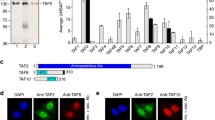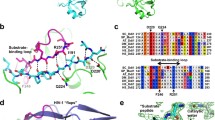Abstract
Human protein phosphatase 1 nuclear targeting subunit (PNUTS) plays critical roles in DNA repair, cell growth and survival. The N-terminal domain of PNUTS mediates interactions with Tox4 and the phosphatase and tensin homolog PTEN, which are essential for the roles of this protein. To study this N-terminal domain, we have established its recombinant overproduction in E. coli utilizing NusA fusion. Upon removal of the tag, the remaining PNUTS sample is soluble and highly pure. We have characterized the domain using circular dichroism and nuclear magnetic resonance and analyzed its sequence using bioinformatics. All data agree in suggesting that the PNUTS N-terminal segment adopts a compact, globular fold rich in α-helical content, where the folded fraction is substantially larger than the previously annotated fold. We conclude that this domain adopts a single fold, likely being an extended form of the transcription factor S-II leucine/tryptophan conserved-motif. Thermal denaturation yielded a melting temperature of ~49.5 °C, confirming the stability of the fold. These findings pave the way for the molecular characterization of functional interactions mediated by the N-terminal region of PNUTS.




Similar content being viewed by others
Abbreviations
- CD:
-
Circular dichroism
- EDTA:
-
Ethylenediaminetetraacetic acid
- HSQC:
-
Heteronuclear single quantum coherence
- NMR:
-
Nuclear magnetic resonance
- PNUTS:
-
Protein phosphatase 1-binding nuclear targeting protein
- PP1:
-
Protein phosphatase 1
- SDS-PAGE:
-
Sodium dodecyl sulfate polyacrylamide gel electrophoresis
- TCEP:
-
Tris-2-carboxyethyl-phosphine
- TFIIS:
-
Transcription factor IIS
- TFIIS LW-motif:
-
Structural motif of the transcription factor IIS with conserved leucine and tryptophan residues
References
Xing Z, Lin A, Li C, Liang K, Wang S, Liu Y, Park PK, Qin L, Wei Y, Hawke DH, Hung M, Lin C, Yang L (2014) lncRNA directs cooperative epigenetic regulation downstream of chemokine signals. Cell 159:1110–1125
Kim YM, Watanabe T, Allen PB, Kim YM, Lee SJ, Greengard P, Nairn AC, Kwon YG (2003) PNUTS, a protein phosphatase 1 (PP1) nuclear targeting subunit. Characterization of its PP1- and RNA-binding domains and regulation by phosphorylation. J Biol Chem 278:13819–13828
Bennett D (2005) Transcriptional control by chromosome-associated protein phosphatase-1. Biochem Soc Trans 33:1444–1446
Ciurciu A, Duncalf L, Jonchere V, Lansdale N, Vasieva O, Glenday P, Rudenko A, Vissi E, Cobbe N, Alphey L, Bennett D (2013) PNUTS/PP1 regulates RNAPII-mediated gene expression and is necessary for developmental growth. PLoS Genet 9:e1003885
Dorn G (2013) miR-34a and the cardiomyopathy of senescence: SALT PNUTS, SALT PNUTS! Cell Metab 17:629–630
Lee J, You J, Dobrota E, Skalnik DG (2010) Identification and characterization of a novel human PP1 phosphatase complex. J Biol Chem 285:24466–24476
Allen PB, Kwon Y, Nairn AC, Greengard P (1998) Isolation and characterization of PNUTS, a putative protein phosphatase 1 nuclear targeting subunit. J Biol Chem 273:4089–4095
Ramakrishnan R, Liu H, Donahue H, Malovannaya A, Qin J, Rice AP (2012) Identification of novel CDK9 and Cyclin T1-associated protein complexes (CCAPs) whose siRNA depletion enhances HIV-1 Tat function. Retrovirology 9:90
Kapoor R, Sakshi A, Sanket SP, Binod K, Subbareddy M, Banerjea AC (2015) MicroRNA34a enhances HIV-1 replication by targeting PNUTS/PPP1R10 which negatively regulates HIV-1 transcriptional complex formation. Biochem J 470:293–302
Landsverk HB, Mora-Bermúdez F, Landsverk OJ, Hasvold G, Naderi S, Bakke O, Ellenberg J, Collas P, Syljuåsen RG, Küntziger T (2010) The protein phosphatase 1 regulator PNUTS is a new component of the DNA damage response. EMBO Rep 11:868–875
Kavela S, Shinde SR, Ratheesh R, Viswakalyan K, Bashyam MD, Gowrishankar S, Vamsy M, Pattnaik S, Rao S, Sastry RA, Srinivasulu M, Chen J, Maddika S (2013) PNUTS functions as a proto-oncogene by sequestering PTEN. Cancer Res 73:205–214
Ling Y, Smith AJ, Morgan GT (2006) A sequence motif conserved in diverse nuclear proteins identifies a protein interaction domain utilised for nuclear targeting by human TFIIS. Nucleic Acids Res 34:2219–2229
Diebold M, Koch M, Loeliger E, Cura V, Winston F, Cavarelli J, Romier C (2010) The structure of an Iws1/Spt6 complex reveals an interaction domain conserved in TFIIS, Elongin A. EMBO J 29:3979–3991
Klug A, Rhodes D (1987) Zinc fingers: a novel protein fold for nucleic acid recognition. Cold Spring Harb Symp Quant Biol 52:473–482
Choy MS, Hieke M, Kumar GS, Lewis GR, Gonzalez-DeWhitt KR, Kessler RP, Stein BJ, Hessenberger M, Nairn AC, Peti W, Page R (2014) Understanding the antagonism of retinoblastoma protein dephosphorylation by PNUTS provides insights into the PP1 regulatory code. Proc Natl Acad Sci USA 111:4097–4102
Bennett D, Lyulcheva E, Alphey L, Hawcroft G (2006) Towards a comprehensive analysis of the protein phosphatase 1 interactome in Drosophila. J Mol Biol 364:196–212
Hildebrand A, Remmert M, Biegert A, So J (2009) Fast and accurate automatic structure prediction with HHpred. Proteins 77:128–132
Biegert A, Lupas AN (2005) The HHpred interactive server for protein homology detection and structure prediction. Nucleic Acids Res 33:244–248
Söding J, Biegert A, Lupas AN (2005) The HHpred interactive server for protein homology detection and structure prediction. Nucleic Acids Res 33:W244–W248
Buchan DW, Minneci F, Nugent TC, Bryson K, Jones DT (2013) Scalable web services for the PSIPRED protein analysis workbench. Nucleic Acids Res 41(W1):W349–W357
Guermeur Y, Geourjon C, Gallinari P, Deléage G, Lyon NSDe, Italie A, Pierre U (1999) Improved performance in protein secondary structure prediction by inhomogeneous score combination. Bioinformatics 15:413–421
King RD, Sternberg MJE (1996) Identification and application of the concepts important for accurate and reliable protein secondary structure prediction. Protein Sci 5:2298–2310
Rost B, Sander C (1993) Prediction of protein secondary structure at better than 70% accuracy. J Mol Biol 232:584–599
Kelley LA, Mezulis S, Yates CM, Wass MN, Sternberg MJE (2015) The Phyre2 web portal for protein modeling, prediction and analysis. Nat Protoc 10:845–858
Whitmore L, Wallace BA (2008) Protein secondary structure analyses from circular dichroism spectroscopy: methods and reference databases. Biopolymers 89:392–400
Sreerama N, Woody RW (2000) Estimation of protein secondary structure from circular dichroism spectra: comparison of CONTIN, SELCON, and CDSSTR methods with an expanded reference set. Anal Biochem 287:252–260
Mitchell A, Chang HY, Daugherty L, Fraser M, Hunter S, Lopez R, McAnulla C, McMenamin C, Nuka G, Pesseat S, Sangrador-Vegas A, Scheremetjew M, Rato C, Yong SY, Bateman A, Punta M, Attwood TK, Sigrist CJ, Redaschi N, Rivoire C, Xenarios I, Kahn D, Guyot D, Bork P, Letunic I, Gough J, Oates M, Haft D, Huang H, Natale DA, Wu CH, Orengo C, Sillitoe I, Mi H, Thomas PD, Finn RD (2015) The InterPro protein families database: the classification resource after 15 years. Nucleic Acids Res 43:D213–D221
Finn RD, Coggill P, Eberhardt RY, Eddy SR, Mistry J, Mitchell AL, Potter SC, Punta M, Qureshi M, Sangrador-Vegas A, Salazar GA, Tate J, Bateman A (2016) The Pfam protein families database: towards a more sustainable future. Nucleic Acids Res 44:D279–D285
Letunic I, Doerks T, Bork P (2015) SMART: recent updates, new developments and status in 2015. Nucleic Acids Res 43:D257–D260
Sigrist CJ, de Castro E, Cerutti L, Cuche BA, Hulo N, Bridge A, Bougueleret L, Xenarios I (2013) New and continuing developments at PROSITE. Nucleic Acids Res 41:D344–D347
Gasteiger E, Hoogland C, Gattiker A, Duvaud S, Wilkins MR, Appel RD, Bairoch A (2005) Protein identification and analysis tools on the ExPASy Server. In: Walker JM (ed) The proteomics protocols handbook. Humana Press, New York, pp 571–607
Author information
Authors and Affiliations
Corresponding authors
Ethics declarations
Conflict of interest
The authors declare that they have no conflicts of interest.
Ethical Approval
This article does not contain any studies with human participants or animals performed by any of the authors.
Rights and permissions
About this article
Cite this article
Zacharchenko, T., Barsukov, I., Rigden, D.J. et al. Biophysical Analysis of the N-Terminal Domain from the Human Protein Phosphatase 1 Nuclear Targeting Subunit PNUTS Suggests an Extended Transcription Factor TFIIS-Like Fold. Protein J 35, 340–345 (2016). https://doi.org/10.1007/s10930-016-9677-7
Published:
Issue Date:
DOI: https://doi.org/10.1007/s10930-016-9677-7




